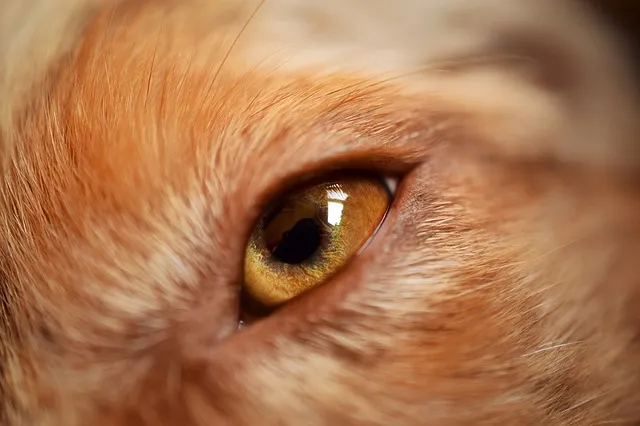Australian shepherds are intelligent, exuberant and a great working dog with their unique looks, some with one-of-a-kind patchwork colors.
Their gaze is piercing and can easily win a staredown with their stellar vision, needed for keeping an eye on sheep when herding.
Along with their awesome coats, Australian shepherds have beautifully colored eyes. Their eyes can be blue, green, brown, amber, and hazel, very close to human shades.
Some pups may even have two different colored eyes known as heterochromia, which is genetic.
Both parents need the gene for their shepherd to have eyes of differing colors, but the parents themselves may just have the gene and not heterochromia themselves.
Australian shepherds are prone to certain eye diseases and conditions. Some types of health problems can be prevented with a good diet, exercise, and health care.
Many eye diseases that Australian shepherds are prone to cannot be prevented because they are genetic in nature and inherited.
In this post, I will give you some important information about Australian shepherd eye diseases and problems, their causes, symptoms, and treatment.

For your dog’s vitamin supplement, food, toys, or other dog products please visit the Sundays for dogs website.
Australian Shepherd Eye Problems
Australian shepherds are prone to a few eye problems and diseases. If you are considering getting an Australian shepherd or an owner of one already, it’s good to do some research about any type of diseases they may be prone to.
Some eye problems can be cured and even prevented, while others are inherited and may have treatments but no cure.
The health issues or eye problems that Australian shepherd is prone to do not mean that there is a 100% chance of acquiring any of these.
They may never develop any eye or health problems. Listed below are eye diseases and problems to look out for in your Australian shepherd.
Cataracts
Cataracts are the most common eye issue that plagues Australian shepherds. Of course geriatric dogs of any breed, just like human senior citizens, can develop cataracts as they age, and just a fact of aging eyes as time marches on.
Unfortunately, Australian shepherds are prone to cataracts that are hereditary and also bilateral, which means they will develop in both eyes, but they may not be at the same time. These are known as juvenile cataracts, developing between two and five years of age, and can gradually cause partial or total blindness if not treated.
Cataracts are sometimes associated with the gene called merle that gives some of these shepherds their blue eyes and patchwork coat.
A cataract develops when the tissue of the lens deteriorates. These can begin with small opaque areas and advance to where the entire lens is clouded.
Cataracts cause no pain, but eventually, your Aussie will only be able to distinguish extremes of darkness and bright light. Vision loss is slow to progress, which helps the shepherd adjust.
Surgery is the only treatment for juvenile cataracts and is similar to human cataract surgery where a clouded lens is replaced with a lens of plastic.
This type of surgery generally has a favorable outcome, but your shepherd must be a good candidate, which will be determined by their veterinarian.
Breeds suffering from juvenile cataracts should not be bred. There is DNA testing available to breeders for this gene.
To check your shepherds’ health status or their DNA checks, please visit the Embark vet website for all the help you may need.

PPA – Persistent Pupillary membrane
This is a problem when a fetal structure, known as the pupillary membrane attaches to the pupil before birth. Generally, this will resolve on its own after birth, however, if it attaches to the cornea or lens it can cause opaque areas, considered blind spots. There is no treatment for PPA but this is not a very common anomaly.
Iris coloboma
Iris coloboma is an eye defect and is evident when an Aussie’s iris does not develop fully. Small or large areas of the iris appear hole-like with a piece or pieces of tissue missing. This condition is evident at birth and may cause no vision issues at all unless this area is large. It may cause your shepherd to squint in the sun and bright light.
Coloboma is usually seen during an ophthalmologic exam or a veterinarian may be able to spot a larger one. Vision is usually not affected but there is no treatment for this malady and dogs should not be bred as it is an inherited condition.

CEA – Collie Eye Anomaly
Collie eye anomaly is a disease that can cause many other eye conditions and is found in some Shetland sheepdogs, border collies, and collies as well as Australian shepherds.
If your Australian shepherd is affected, it will be present at birth and is another genetic disease with the cause being a gene mutation that is recessive.
If CEA is mild in your pup at birth, it will not progress. Some pups at birth will already suffer from serious defects from CEA such as retinal separation and eye dysplasia, both of which can cause blindness.
For CEA to occur, both parents must be carriers. Shepherds should not be bred. There is no cure or treatment and puppies should be checked for CEA at birth. This condition is not as common due to careful breeding, using no carriers.
PRA – Progressive Retinal Atrophy
The Australian Shepherd is a breed of several that are prone to PRA or progressive retinal atrophy. This disease will present early on and night blindness is the beginning symptom, becoming progressively worse until total blindness occurs.
There is no cure for PRA, although dogs usually adjust quite well because it is a gradual process. The only treatment is to be prepared. Again, shepherds carrying this gene should not be bred.
Distichiasis
Distichiasis is a defect of the eye causing eyelashes to grow abnormally toward the cornea. Every time your shepherd blinks, this can cause scratching, pain, and even scarring of the cornea.
Often, the lashes are soft and don’t cause a problem, and other times if lashes are thick and stiff, they need to be surgically removed.
You wouldn’t think it, but distichiasis is an inherited condition and is common in Australian shepherds. if this is chronic and requires surgery, dogs should not be bred.

Conjunctivitis in Dog
Conjunctivitis is one of the most common eye conditions in any breed of dog and is often referred to as “pink eye.” It is an inflammation of the mucus membrane or conjunctiva, that covers your shepherd’s eye.
The lining of the eyelid will also be inflamed. This is usually caused by a bacterial infection. Symptoms will be a red swollen eye with discharge that can be watery, but most often with pus or mucus.
Conjunctivitis is treated with antibiotic eye drops, sometimes along with oral antibiotics if it is severe.
Even though your Australian shepherd relies on their sense of smell for many things, their vision is highly important and necessary.
You can ensure that your pup has excellent vision by first choosing a reputable breeder and one that uses DNA testing for their breeding dogs to guard against genetic defects. This, of course, is not foolproof and does not totally guarantee your pup will never suffer from any illness, but breeders usually have contracts stating what is guaranteed and what is not.
You can feed your pup a healthy nutritious diet and make sure they have regular wellness visits, where their vet can check everything, especially their eyes to catch anything early on. You can also check out your pup’s eyes from time to time with a flashlight, just to make sure their eyes are bright, clear, and showing nothing out of the ordinary.
Some pups have more eye discharge than others. Simply clean it away gently, with a damp, soft cloth or cotton.
If you notice an excessive discharge that is thick or discolored or with constant crusting around their eyes, have your veterinarian take a look.
Australian shepherds are prone to the conditions above but that doesn’t mean they will develop any of these either as a pup or older shepherd.
Keep in mind that even dogs who do unfortunately lose their eyesight, have gone on to live happy and full lives. Dogs do adjust well.
The key, though, is prevention, preparedness, and regular veterinary visits. If you have any concerns always contact your Australian shepherd’s veterinarian.
To maintain your Australian Shepherd’s eye health, you should:
– Schedule regular veterinary check-ups and consider visiting a veterinary ophthalmologist for specialized eye exams, especially if you suspect any issues.
– Keep their eyes clean
– Protect their eyes from excessive sun exposure or harmful chemicals.
– Be aware of any changes in their behavior, such as excessive rubbing of the eyes or squinting, which may indicate eye discomfort.
If you are considering getting an Australian Shepherd, make sure to choose a reputable breeder who tests their breeding dogs for hereditary eye conditions and follows responsible breeding practices to reduce the risk of passing on genetic eye problems to their offspring. Additionally, adopt good eye care practices and seek prompt veterinary care if you notice any signs of eye trouble in your Australian Shepherd.